Irrigation Check List

Whatever your surface - football stadium, golf course, cricket ground or rugby pitch - effective irrigation is vital to have the healthiest grass and to affect the playability, whether that's a slick, fast-paced game or heavier, slower game. Yet, when it comes to good housekeeping, quite often irrigation does not attract the same attention as the specialist machinery cutting the grass.
Attention to the upkeep and efficiency of machinery is an accepted, essential part of general best practice management; it ensures best quality of cut at all times and helps extend the life of the machine. Just as careful monitoring of a machine's performance will help to identify individual problems due to faults or poor maintenance, effective irrigation is a maintenance must, but many persevere with problems.
Routine irrigation inspections are as important as any other aspect of professional turf maintenance and allow you to take control of any issues, providing the opportunity to correct them before they turn into bigger, more costly problems. The consequences can vary from a component frustratingly having to be replaced before it needs to or, worst-case scenario, lots of downtime and large costs renovating or refitting the entire system prematurely.
In my experience, having a checklist breaks down what could otherwise be a pretty big job into more manageable tasks. Having note of all the aspects requiring careful and consistent monitoring, and ticking them off as you go along, incorporates irrigation maintenance into a routine.

Visual checks
It's best to look at the overall performance of your irrigation system throughout the season on a weekly basis minimum, but this can be a big job and one often shared with the grounds/greens team contributing, checking the turf whilst they mow, taking pictures, and reporting back any issues.
The first signs that an irrigation system is experiencing problems are mainly visual - dry patches, soggy turf, run-off and areas of pooling, for example. A few years ago, I visited a golf club that thought it had sprinkler performance issues; when I arrived, I saw a green stripe of turf running along where the course's mainline would be, in contrast to some surrounding brown areas, which immediately suggested the problem wasn't the sprinklers, but a leak in the pipework.
Flushing the system
Flushing the system prevents clogging and reduces the accumulation of pollutants such as stagnant water, sand or soil. Flushing involves opening the valves in the mainline, sub-main line or laterals whilst under pressure. With the increase in water flow velocity, pollutants are pushed out of the system. The system should be flushed at regular intervals and frequency depends on the water quality and the age of the system, but I'd certainly aim to do this at the start of spring, after the cold weather, ready for the new season.
Pipes
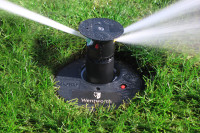
If you have had a burst, once fixed, it's important to flush that section of the pipework extensively to prevent any pollutants travelling through the system, potentially causing further blockages. Similarly, if you have a new system, flushing before operating will eliminate any installation remnants and shavings from the pipework.
Seasonal checks
It's easy with an irrigation system to fall into the trap of out of sight out of mind; but regular checking is important for the longevity and 'health' of your system. It goes without saying that you wouldn't expect your machinery to run well if you hadn't changed the oil for ten years, so it's a good idea, similarly to winter and spring machinery maintenance, to give your irrigation system a thorough seasonal check. It's equivalent to giving your irrigation system a good MOT, giving you the confidence that your system is fit for purpose.
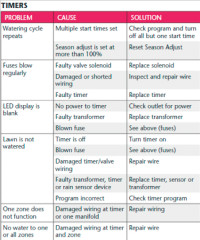
Irrigation Wall Mounted Controllers
First of all, check the displays. If incorrect information is showing, that could identify a recent power surge or outage, whilst no display at all indicates a problem with the wiring, or it could be as simple as a blown fuse.
You may have been alerted to an issue because the water cycle is repeating, the sward is not watered, one zone does not function or there's no water to one or all of the zones. Our handy chart on Controllers indicates possible causes for all these scenarios and solutions - see table 1.
If the system is ramping up all the time with the pumps switching on and off or, in an older system, if the pressure keeps dropping, these signs generally indicate a leak or burst and, if that's the case, speed is of the essence to get it fixed and minimise expense. The energy cost of the system continuously bringing in the pumps, plus paying for wasted water at, say, £1.75 per cubic metre, will soon add up.
Valves
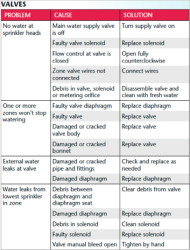
Issues with sprinklers are important to resolve. Depending on the system you have, a problem with one sprinkler can affect all of those in the cable zone, stopping others from working. Checking spray pattern and adjusting the flow control at the valve, and cleaning pop-up heads including dirty filters, will prevent rotary heads from sticking and ensure a smooth rotation, whilst checking the seals and rotation of the sprinkler risers will prevent water damage to the surrounding turf. Table 2 has more.
Sprinklers
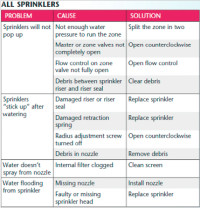
Being exposed as they are, sprinklers are subject to a great deal of wear and it is recommended they are replaced every few years. Remarkably, the simple job of renewing an aged sprinkler nozzle alone can increase the efficiency of your system by up to ten percent at the right pressure and flow. With nozzles costing, on average, just £15 per head, this can be a highly cost-effective way of improving your system and is a job easily handled by the greens/grounds teams.
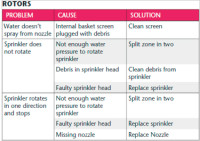
Rotation flaws are likely an indication of debris in the sprinkler head, a pressure problem, improperly adjusted flow-control valve. Damage or normal wear and tear could also be possible culprits. Possible causes and solutions are indicated in table 4.
Remedial work such as this can improve efficiency of your system by around twenty percent, plus, by taking control of your irrigation system, you are eliminating the need to bring in a contractor at an extra cost. This again comes back to viewing irrigation as you would machinery - most of us wouldn't bring a mechanic in to advise on problems with a machinery fleet, unless you had some idea of the issues yourself, and the same rules apply to your irrigation system; it's all about knowing how to identify the issues so you can save bringing in a service engineer or contractor until you need to.

A rapid decline in performance and consistent problems are when the input from a consultant will be essential, and their diagnosis will better help you decide whether to carry out remedial work to salvage an ailing system or bite the bullet and invest in new. But overall, daily, weekly and seasonal checks should become part of the routine, with a service engineer and contractor doing what they do best - an annual full system check, control system/electrical issues, or advising on refits.
Properly maintaining your irrigation system doesn't have to be costly or time-consuming. Identifying problems and taking control of your club's irrigation maintenance will keep costs low and your system efficient.
